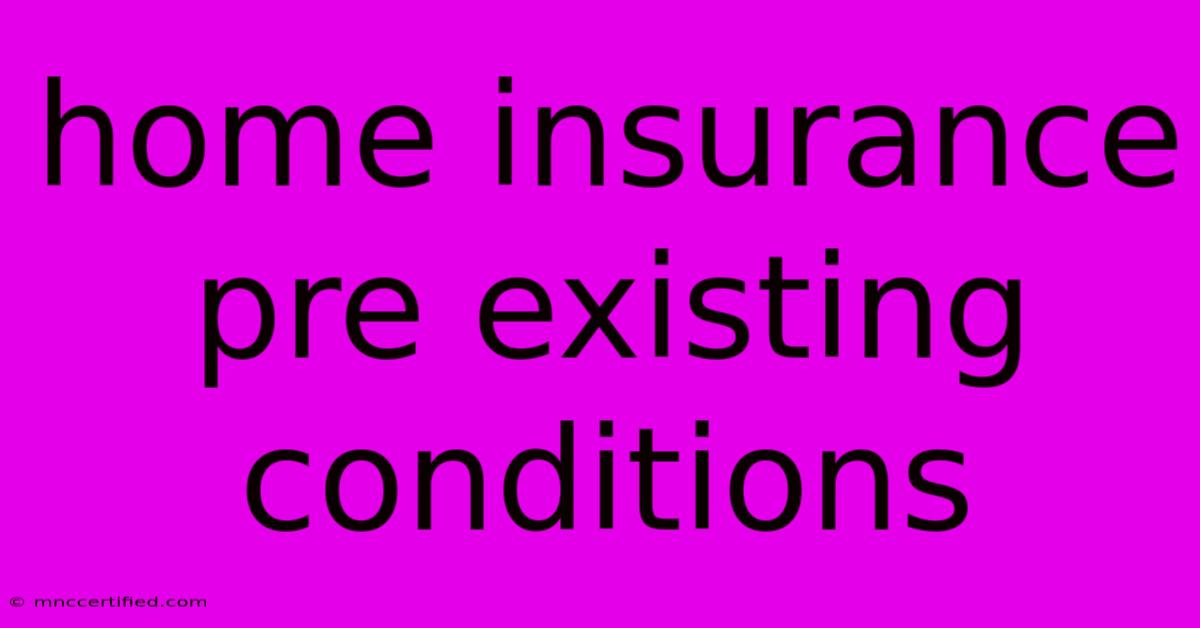Home Insurance Pre Existing Conditions

Table of Contents
Understanding Home Insurance Pre-Existing Conditions: A Comprehensive Guide
When securing home insurance, many individuals might encounter the term "pre-existing conditions." This can be a confusing concept, often leaving homeowners wondering what it entails and how it affects their coverage. This article will demystify pre-existing conditions in the context of home insurance, helping you navigate this important aspect of your policy.
What are Pre-Existing Conditions in Home Insurance?
In essence, pre-existing conditions in home insurance refer to existing issues or problems with your property that were present before you purchased the policy. These issues can include:
- Structural defects: This could encompass problems like foundation cracks, roof leaks, or faulty wiring.
- Previous damage: If your property has been previously damaged by events such as fire, floods, or earthquakes, this may be considered a pre-existing condition.
- Neglect or improper maintenance: Unmaintained property can lead to issues like mold, pest infestations, or deterioration, which insurance companies might classify as pre-existing conditions.
How Pre-Existing Conditions Impact Your Coverage
Pre-existing conditions can significantly impact your home insurance coverage in various ways:
- Exclusions: The insurance company might exclude coverage for specific pre-existing conditions, meaning they won't compensate for damages related to those issues.
- Higher premiums: Your insurance premiums could be higher if your property has pre-existing conditions, reflecting the increased risk for the insurer.
- Conditional coverage: Some pre-existing conditions might be covered, but only under certain conditions. For example, you may have to provide proof of repairs or maintenance before the insurer covers future damages related to that condition.
How to Handle Pre-Existing Conditions
1. Disclosure is Key: It's crucial to disclose all known pre-existing conditions to your insurance provider before purchasing the policy. Failure to disclose can lead to policy rejection or claim denial later on.
2. Get Expert Assessments: For significant pre-existing conditions like structural defects, seek professional assessments from licensed inspectors or contractors. This provides documented evidence for your insurance provider.
3. Address Existing Issues: Whenever possible, address pre-existing conditions by undertaking necessary repairs or maintenance. This demonstrates your commitment to maintaining your property and can influence the insurance company's decision.
4. Negotiate Coverage: Don't hesitate to negotiate with insurers to understand how pre-existing conditions will impact your coverage. Explain your situation and explore potential solutions, such as conditional coverage or higher premiums.
5. Explore Specialized Insurance: If your property has extensive pre-existing conditions, specialized insurance options might be available. Consult an insurance broker to explore these options and find the best fit for your unique circumstances.
Conclusion
Navigating pre-existing conditions in home insurance can be challenging, but understanding the process is crucial. By being proactive, disclosing relevant information, and addressing existing issues, you can obtain adequate coverage for your property and avoid potential problems later on. Remember, consulting with an insurance professional is always a good idea to ensure you make informed decisions regarding your home insurance.

Thank you for visiting our website wich cover about Home Insurance Pre Existing Conditions. We hope the information provided has been useful to you. Feel free to contact us if you have any questions or need further assistance. See you next time and dont miss to bookmark.
Featured Posts
-
Tonights Have I Got News For You Lineup
Nov 09, 2024
-
Alliance Insurance Group Montgomery Al
Nov 09, 2024
-
Nicole Scherzinger Issues Apology For Controversy
Nov 09, 2024
-
Taylors Insurance South Hill Virginia
Nov 09, 2024
-
Maleic Bond Repair Complex 3 5 Shampoo
Nov 09, 2024